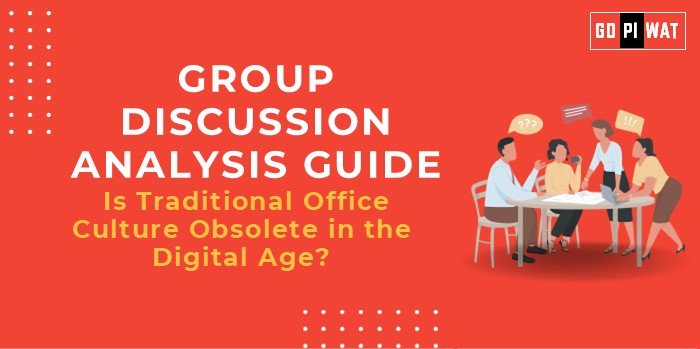📋 GROUP DISCUSSION ANALYSIS GUIDE: Is Traditional Office Culture Obsolete in the Digital Age?
🌐 Introduction to the Topic
Opening Context: “The COVID-19 pandemic accelerated a worldwide shift towards remote work, sparking a debate on whether traditional office culture remains relevant in an era dominated by digital connectivity and hybrid workspaces.”
Topic Background: Traditional office culture, characterized by in-person collaboration and hierarchical setups, has been challenged by the rise of remote work tools, cloud technologies, and flexible work environments. While companies have adopted digital-first approaches, questions remain regarding its sustainability, employee engagement, and organizational productivity.
📊 Quick Facts and Key Statistics
- 📈 Remote Workforce Adoption: 30% of global companies have adopted permanent hybrid work policies post-pandemic (Gartner, 2024).
- ⚡ Productivity Perception: 70% of employees report higher productivity working remotely (PwC, 2024).
- 🏢 Office Space Reduction: Global demand for office spaces has dropped by 15% post-2020 (CBRE Report).
- 🧠 Mental Health Challenges: 67% of remote employees face social isolation issues, impacting team cohesion (Forbes, 2024).
- 💰 Cost Savings: Companies save up to $11,000 annually per employee working remotely (Global Workplace Analytics, 2023).
🔑 Stakeholders and Their Roles
- 🏢 Organizations: Driving policies for productivity, cost savings, and culture retention in a hybrid work environment.
- 👩💻 Employees: Balancing work-life integration, career growth, and skill development in remote/hybrid setups.
- 🖥️ Technology Companies: Enabling tools (e.g., Zoom, Slack, MS Teams) that redefine communication and collaboration.
- ⚖️ Governments: Developing labor policies for flexible work conditions and ensuring data security in remote setups.
🏆 Achievements and Challenges
🌟 Achievements:
- ✨ Enhanced Flexibility: Improved work-life balance, leading to better job satisfaction and retention.
- 💵 Cost-Efficiency: Reduction in infrastructure costs and overheads.
- 🌍 Talent Diversification: Access to a global talent pool without geographic limitations.
- 🚀 Tech Innovation: Growth in digital collaboration tools and cloud-based solutions.
⚠️ Challenges:
- 📉 Workplace Culture Erosion: Lack of in-person collaboration impacts creativity, mentorship, and engagement.
- 😵 Digital Fatigue: Over-reliance on virtual meetings causes burnout and reduced employee well-being.
- 🏭 Productivity Disparities: Not all sectors (e.g., manufacturing, logistics) can adopt remote work fully.
🌏 Global Comparisons
- 🇺🇸 US: Large corporations like Twitter and Meta adopted permanent remote/hybrid models.
- 🇯🇵 Japan: Struggles to shift due to strong traditional office norms and a culture of face-time.
📌 Case Study: TCS Hybrid Work Model
TCS introduced a “25×25” plan where 25% of employees will work from offices by 2025, cutting costs while maintaining engagement.
💬 Structured Arguments for Discussion
- 💡 Supporting Stance: “Digital tools, cost savings, and improved flexibility make traditional office culture obsolete, fostering efficiency and inclusivity.”
- 👥 Opposing Stance: “Traditional offices enable stronger team dynamics, innovation, and mentorship, which virtual spaces cannot fully replicate.”
- ⚖️ Balanced Perspective: “While remote work offers benefits, a hybrid model combining digital and in-person elements strikes the ideal balance.”
🎯 Effective Discussion Approaches
- Opening Approaches:
- 📊 “Studies show that companies save $11,000 annually per employee working remotely. Is office culture still necessary in such a scenario?”
- 💭 “The pandemic proved remote work can succeed, but what have we lost in terms of innovation and workplace camaraderie?”
- Counter-Argument Handling:
- Challenge: “Face-to-face collaboration is irreplaceable.”
Rebuttal: “Platforms like Miro and Slack mimic collaborative spaces effectively, with the added flexibility of location.”
- Challenge: “Face-to-face collaboration is irreplaceable.”
📈 Strategic Analysis of Strengths and Weaknesses
- 🏆 Strengths: Cost savings, access to global talent, improved work-life integration.
- ⚠️ Weaknesses: Decline in teamwork and creativity, social isolation, and employee burnout.
- ✨ Opportunities: Hybrid models to retain office culture benefits, advanced VR/AR tools for immersive collaboration.
- ⚡ Threats: Productivity variations among industries, increasing cybersecurity risks in remote setups.
📚 Connecting with B-School Applications
- 📘 Real-World Applications: Exploring new-age leadership models for hybrid workforces.
- 📊 Operations Management: Optimizing office space utilization in a flexible work environment.
Sample Interview Questions:
- “How do you foresee office culture evolving in the next decade?”
- “What role does leadership play in managing a fully remote team?”
Insights for B-School Students: Leadership skills are evolving—future managers must balance digital tools and human engagement. Emphasis on technology-driven team collaboration and inclusivity is essential for modern organizations.


